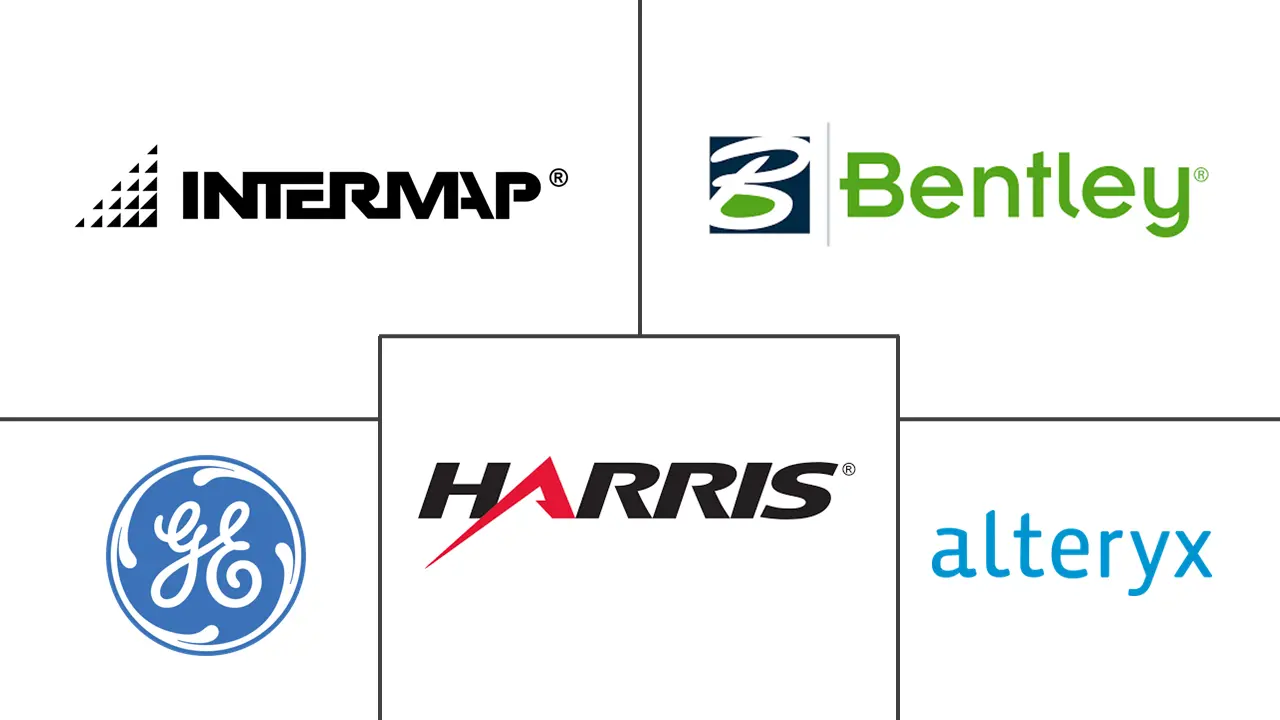United States Geospatial Analytics Market Size and Share
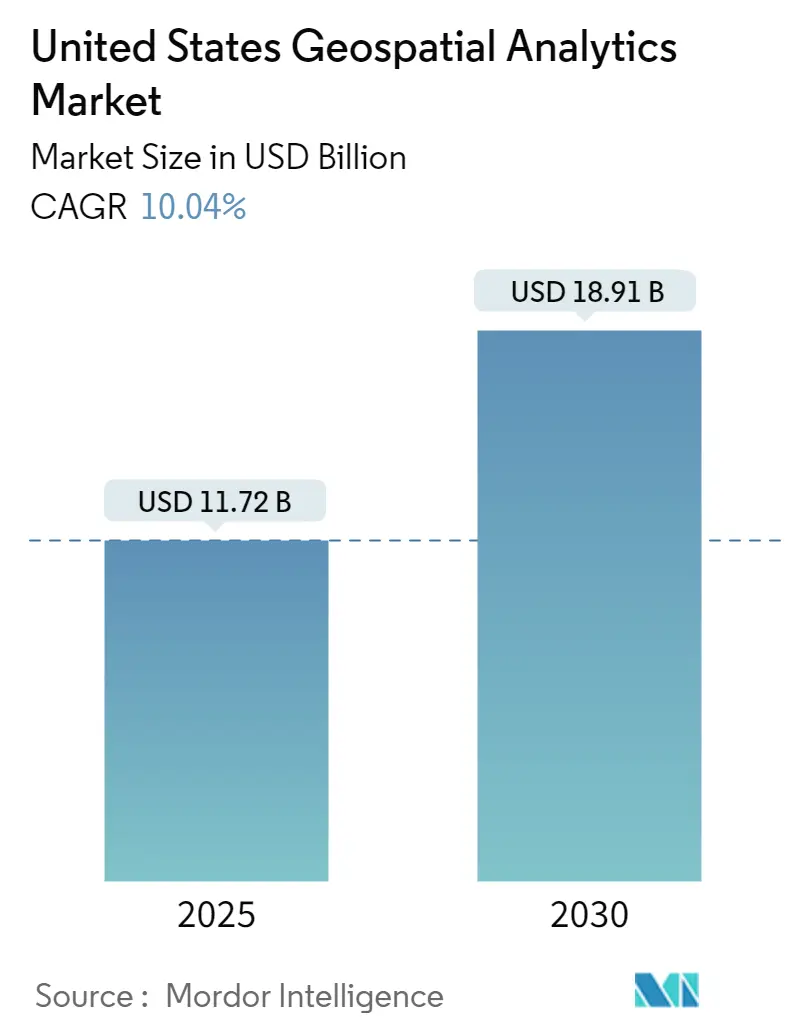
United States Geospatial Analytics Market Analysis by Mordor Intelligence
The United States Geospatial Analytics Market size is estimated at USD 11.72 billion in 2025, and is expected to reach USD 18.91 billion by 2030, at a CAGR of 10.04% during the forecast period (2025-2030).
Geospatial analysis refers to a broad range of activities that emphasize applying various techniques to data comprising geographical or space-related characteristics. The increasing use of GPS devices, technological advancements in the field of GIS technology, recent trends in the integration and convergence of geospatial technologies, the emergence of new business models aimed at leveraging the demand for geospatial information, and the increased application of geospatial analytics in city and town planning are some of the primary factors driving the expansion of the market for geospatial analytics.
- Geospatial analytics can play a significant role in residential construction. By leveraging tools like Geographic Information Systems (GIS), builders and developers can make informed decisions based on data-driven insights related to the location, zoning, and available resources.
- GIS technology can be used in residential construction to facilitate everything from site selection to project management. For example, GIS can be used to analyze the terrain of a potential construction site to determine whether it is suitable for building. Additionally, GIS can help builders to identify potential environmental hazards that may need to be taken into consideration during the construction process.
- According to US Census Bureau, Texas and Florida were the states with the most residential building permits issued in 2022, which amounted to over 210,000. The South of the United States saw a higher number of new housing starts, 834,100 in 2022. The West had the second-highest number of housing starts in 2022, with approximately 370,600 units. In 2022, only the Northeast of the United States saw an increase in housing starts. Such huge rise in the residential construction would drive the studied market.
- Further, Surface analysis is widely used in disaster mitigation and location planning, as they effectively use esoteric mapping to determine the probability of disasters. The general surface characteristics (such as slope, aspect, and curvature) are primarily used for analyzing the variations in the surface of a study object. For instance, the 'slope' metric is extensively used to define the areas of a region that are highly prone to landslides, whereas 'curvature' is used to determine areas prone to damage. In addition, the slope aspect can be used with the geological structure to assess rock beds that may be useful for planning roads and other constructions, especially in hilly terrains.
- Conversely, high costs and operational concerns could improve the geospatial analytics market's adoption rate, such as the limited presence of open standards and interoperability mechanisms and integration issues between ERM and GIS systems. Although the overall expenses of geospatial analysis solutions have decreased drastically since the turn of the decade, owing to the greater availability of open-source tools and plunging hardware costs, it remains a significant concern for small and medium-scale companies. Generic location-based data is readily available over the Internet; however, it offers limited demographic insights and could be more useful for making strategic decisions.
United States Geospatial Analytics Market Trends and Insights
Network Analysis is Expected to Hold Significant Share of the Market
- Network Analysis enables end-users to incorporate location-based information into their decision-making process. In several cases, firms must consider all possible cases for making effective decisions regarding cost and resources. GIS is widely used for studying real-world problems related to operations research and flow-related issues, such as transportation research. Some significant applications of network analysis in operations research include selecting the best route, shortest path analysis, optimal allocation of finite resources, network partitioning, selection of closest maintenance facility, and location-allocation, among others.
- The use of network analysis has gained prominence in today's cities, which are becoming increasingly congested. For instance, in the case of any emergency response system (ERS), the best route or shortest path analysis data using spatial data directly improves the fire emergency response, police station emergency response, healthcare emergency response system, etc. Google Maps extensively uses spatial data to provide multiple routes, the best routes, and real-time analysis to re-route in case the user cannot follow the suggested path.
- The players in the market are collaborating to provide better services to its customer and expand their market presence. For example, Mapbox, one of the prominent mapping and location cloud platforms for developers, and Ookla, the renowned company that developed Speedtest and Downdetector, have joined forces worldwide to develop ground-breaking network-aware mapping solutions. Technologies that offer significant new value to each company's customers will be developed together. Because of their combined capabilities and expertise, Ookla and Mapbox are uniquely positioned to transform connectivity-aware mapping features and geospatial network analysis.
- Further, in April 2023, SpaceKnow and Chia Network, Inc. have announced a partnership to unlock actionable space intelligence and data for the benefit of sustainability initiatives, beginning with the AgroTech sector. SpaceKnow and Chia will create and maintain a geospatial database to track land enrollment in sustainability programs. Secured with Chia's Virtual Private Blockchain, the database will be trusted and spatially accessible to authorized market participants. By establishing auditable procedures that guarantee accuracy and foster market trust, the technology solution seeks to address industry issues. This geospatial database will inform project developers and standards, monitor participant field activity, and help leverage data to encourage program participation and engagement.
- Geospatial network analysis is crucial in the mining industry to identify essential habitat patches and plan and manage mining operations. With the help of geographic information systems (GIS), spatial databases, and specialized software tools, mining companies can perform spatial analyses, create linear networks of interconnected features, and perform detailed spatial analyses on them. Such tools help identify ecological sources based on morphology, create vector-based network analysis to optimize transportation, and use spatial data mining to solve complex problems. According to US Geological Survey, In 2023, the capacity utilization of the United States' mining industry stood at an estimated 93%. Such huge in mining capacity would drive the studied market
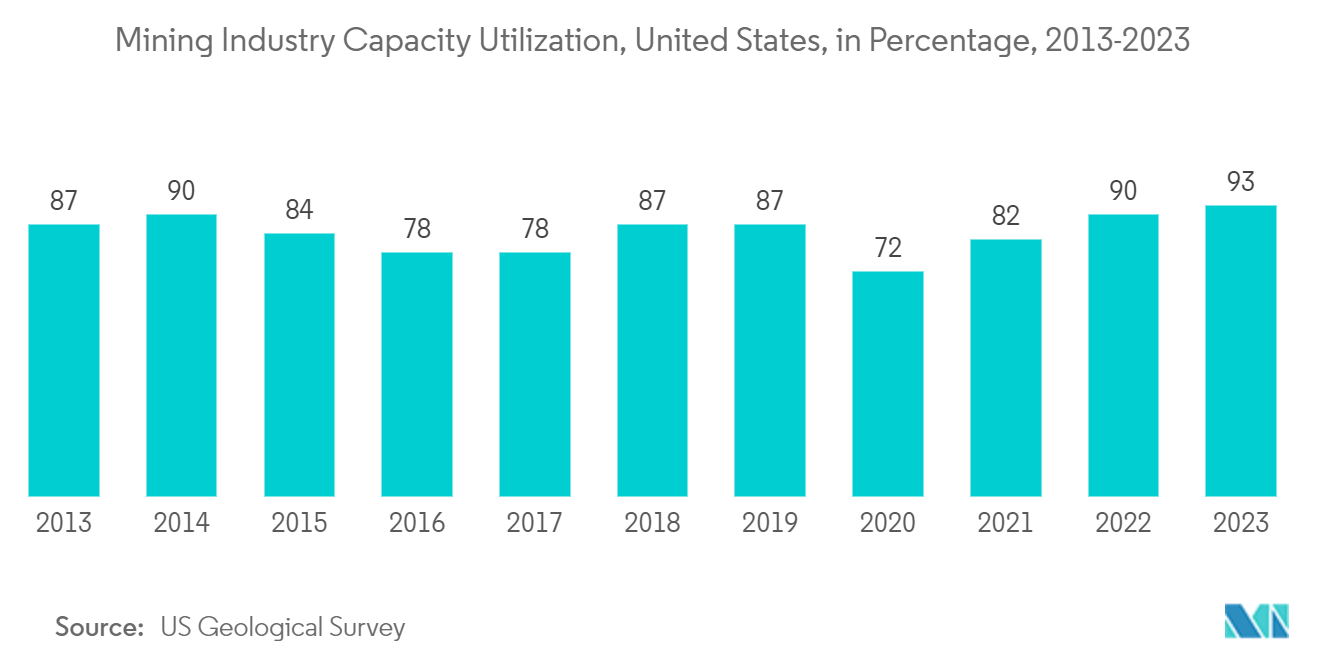
Defense and Intelligence is Expected to Hold Significant Share of the Market
- Geospatial analytics plays a significant role in making decisions about national security involving geography. It is essential to understand the geographical data to assess potential terrorist targets and determine the place of a strike on the battlefield. Data analysis can also decide where to locate a new building with minimal environmental impact. For instance, the US army uses geospatial analytic tools to boost its terrain awareness. Under the US government administration, increased spending on US defense has led to a growing demand for geospatial analytics. Mounting geopolitical tensions in Asia-Pacific, Iran, and the United States, are also responsible for the increased demand.
- There are regulations in the United States regarding geospatial analytics and defense. The National Geospatial-Intelligence Agency (NGA) is a combat support agency within the United States Department of Defense that collects, analyzes, and distributes geospatial intelligence (GEOINT) to support national security. The agency assists in security planning for major events and has a mission in GEOINT. The regulations related to geospatial analytics and defense are governed by the Export Administration Regulations (EAR) under the U.S. Department of Commerce. These regulations control the export of "dual-use" technologies (i.e., those with civil and military applications), including geospatial software and data.
- Further, one of the key technologies used in the network defense of the United States is EINSTEIN, which is an intrusion detection system operated by the Cybersecurity and Infrastructure Security Agency (CISA). EINSTEIN provides real-time network security and threat indicators by identifying and blocking unauthorized traffic before it enters a government network. Additionally, Palantir Gotham, a big data analytics tool, is used by counter-terrorism analysts at offices in the United States Intelligence Community (USIC) and Department of Defense (DoD). Lastly, Cisco Secure Network Analytics is a tool that provides network detection and response to help defend against cyber threats.
- Geovisualization enables defense industry players accelerate decision-making, workflows, policies, and engagement with the use of a Geographic Information System (GIS). GIS is used to support various defense missions, including intelligence, operations, and readiness, by integrating those disciplines into a common environment. GIS is also used for military logistics, such as moving supplies, equipment, and troops where they are needed at the right time. It can also be used for defence site management to manage bases and detachments across all levels of command. Some examples of GIS applications in defense include the use of cloud-based GIS, AI, big data, and other remote sensing technologies.
- According to SIPRI, In 2023, the United States topped the list of countries with the highest military expenditure, allocating 916 billion USD for defense purposes. This made up more than 40 percent of the global military expenditure in that year, totaling 2.4 trillion USD.
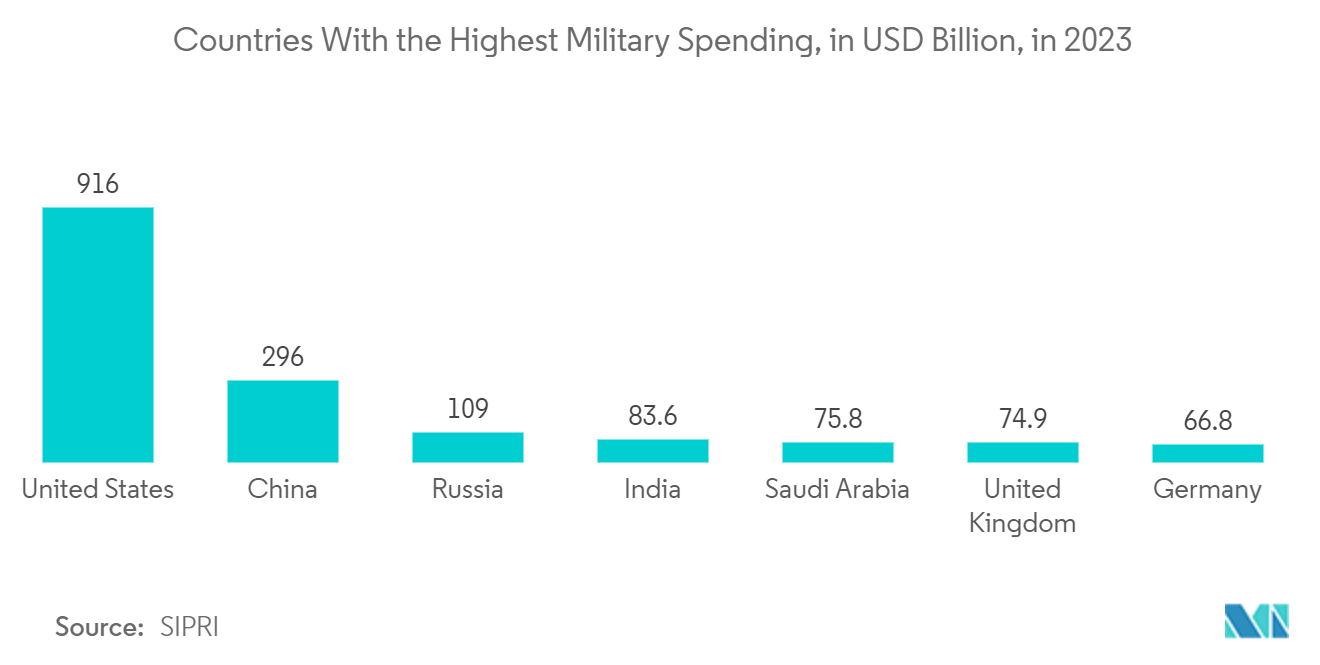
Competitive Landscape
The United states geospatial analytics market is moderately consolidated with the presence of several players like Harris Corporation,Bentley Systems, Inc., Alteryx Inc, General Electric etc. The companies continuously invest in strategic partnerships and product developments to gain substantial market share. Some of the recent developments in the market are:
- In June 2023, The newly acquired subsidiary of NV5 Global, Axim Geospatial, received a prime contract from the National Geospatial-Intelligence Agency (NGA) as part of the GEOINT Enterprise Operations Service and Solutions Program with Industry, Core Mission Operations (GEO-SPI B), according to the announcement made by NV5 Global. GEO-SPI B is a multi-award, seven-year contract vehicle with a maximum value of USD 900 million that focuses on providing NGA's Analysis and Source Directorates with reliable geospatial intelligence (GEOINT). Axim Geospatial's most significant contract win is the GEO-SPI B contract. GEO-SPI B is the follow-on contract to NGA's largest geospatial staff augmentation program, the Multi-Intelligence Analytics and Collection Support Services (MACSS) contract.
- In March 2023, Wejo Group Limited, a global player in Smart Mobility for Good cloud and software solutions for connected, electric, and autonomous vehicle data, has announced a collaboration with the University Consortium for Geographic Information Science (UCGIS), a non-profit organisation that establishes and supports communities of practise for GIScience research, education, and policy endeavours in higher education and allied institutions. Through the collaboration, the 60 UCGIS member institutions and European Union affiliates will be able to use Wejo's data, which has been curated from around 20 million cars and over 94 billion travels, to enhance geographic information science research, education, and activism throughout the world.
United States Geospatial Analytics Industry Leaders
-
Harris Corporation
-
Bentley Systems, Inc.
-
Alteryx Inc.
-
General Electric
-
Intermap Technologies Inc
- *Disclaimer: Major Players sorted in no particular order
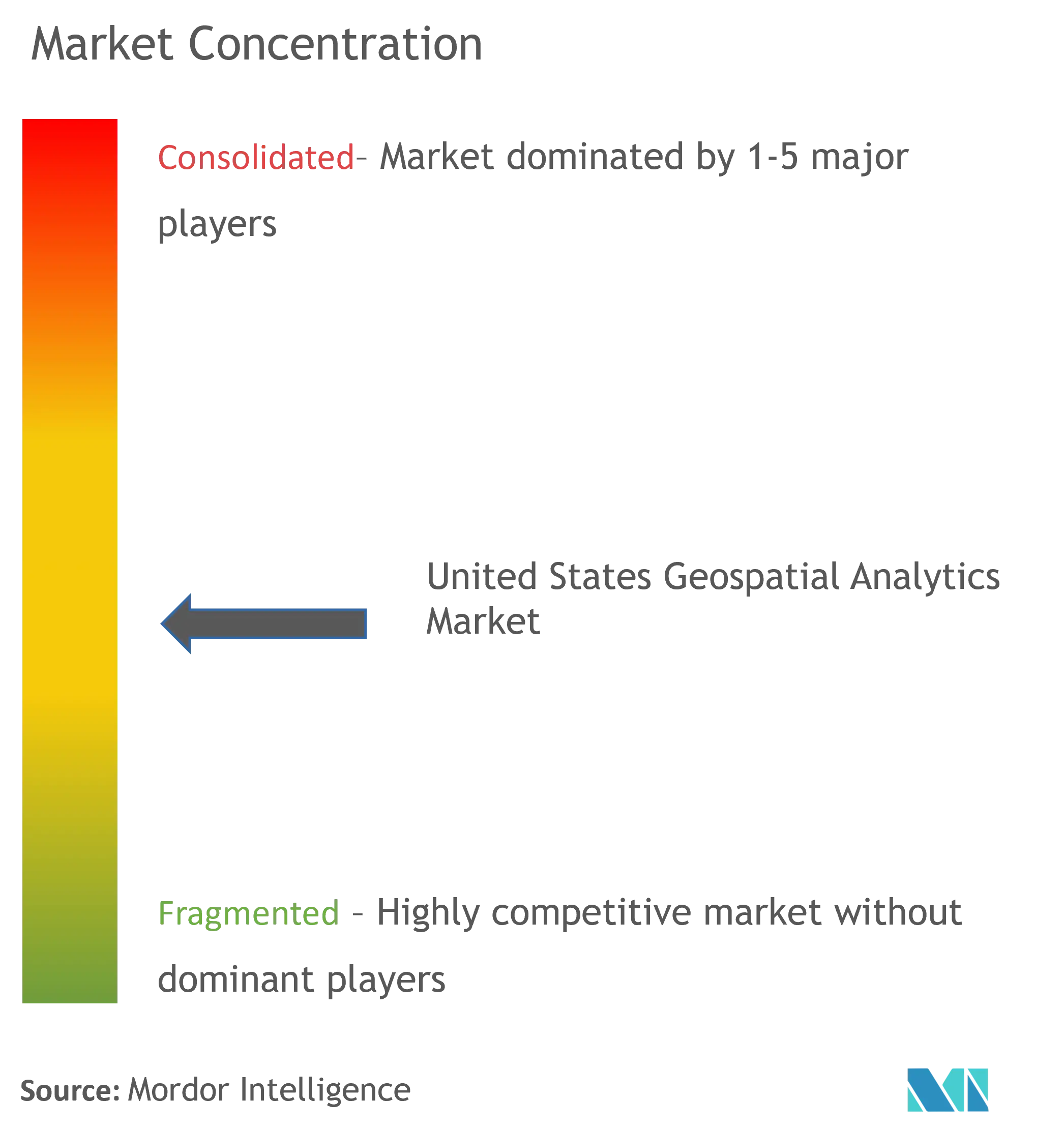
Recent Industry Developments
- May 2023 : CAPE Analytics, a player in AI-powered geospatial property intelligence, has extended its partnership with The Hanover Insurance Group, which provides independent agents with the best insurance coverage and prices. Integrating geospatial analytics and inspection and rating models into Hanover's underwriting procedure is the central component of the partnership expansion. The company's rating plans will benefit from this strategic move, which will improve workflows, new and renewal underwriting outcomes, and pricing segmentation.
- March 2023 : Carahsoft Technology Corp., The Trusted Government IT Solutions Provider, and Orbital Insight, a player in geospatial intelligence, announced a partnership. By the terms of the agreement, Carahsoft will act as Orbital Insight's Master Government Aggregator, making the leading AI-powered geospatial data analytics available to the public sector through Carahsoft's reseller partners and contracts for Information Technology Enterprise Solutions - Software 2 (ITES-SW2), NASA Solutions for Enterprise-Wide Procurement (SEWP) V, National Association of State Procurement Officials (NASPO) ValuePoint, National Cooperative Purchasing.
United States Geospatial Analytics Market Report Scope
Geospatial analytics is the process of acquiring, manipulating, and displaying imagery and data from the geographic information system (GIS), such as satellite photos and GPS data. The specific identifiers of a street address and a zip code are used in geospatial data analytics. They are used to create geographic models and data visualizations for more accurate trends modeling and forecasting.
The United States geospatial analytics market is segmented by type (surface analysis, network analysis, geovisualization) , by end user vertical (agriculture, utility and communication, defence and intelligence, government, mining and natural resources, automotive and transportation, healthcare, real estate and construction). Them market sizes and forecasts are provided in terms of value (USD) for all the above segments.
| Surface Analysis |
| Network Analysis |
| Geovisualization |
| Agriculture |
| Utility and Communication |
| Defense and Intelligence |
| Government |
| Mining and Natural Resources |
| Automotive and Transportation |
| Healthcare |
| Real Estate and Construction |
| Other End-user Verticals |
| By Type | Surface Analysis |
| Network Analysis | |
| Geovisualization | |
| By End-user Vertical | Agriculture |
| Utility and Communication | |
| Defense and Intelligence | |
| Government | |
| Mining and Natural Resources | |
| Automotive and Transportation | |
| Healthcare | |
| Real Estate and Construction | |
| Other End-user Verticals |
Key Questions Answered in the Report
How big is the United States Geospatial Analytics Market?
The United States Geospatial Analytics Market size is expected to reach USD 11.72 billion in 2025 and grow at a CAGR of 10.04% to reach USD 18.91 billion by 2030.
What is the current United States Geospatial Analytics Market size?
In 2025, the United States Geospatial Analytics Market size is expected to reach USD 11.72 billion.
Who are the key players in United States Geospatial Analytics Market?
Harris Corporation, Bentley Systems, Inc., Alteryx Inc., General Electric and Intermap Technologies Inc are the major companies operating in the United States Geospatial Analytics Market.
What years does this United States Geospatial Analytics Market cover, and what was the market size in 2024?
In 2024, the United States Geospatial Analytics Market size was estimated at USD 10.54 billion. The report covers the United States Geospatial Analytics Market historical market size for years: 2019, 2020, 2021, 2022, 2023 and 2024. The report also forecasts the United States Geospatial Analytics Market size for years: 2025, 2026, 2027, 2028, 2029 and 2030.
Page last updated on:
United States Geospatial Analytics Market Report
Statistics for the 2025 United States Geospatial Analytics market share, size and revenue growth rate, created by Mordor Intelligence™ Industry Reports. United States Geospatial Analytics analysis includes a market forecast outlook for 2025 to 2030 and historical overview. Get a sample of this industry analysis as a free report PDF download.
